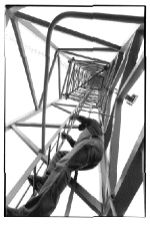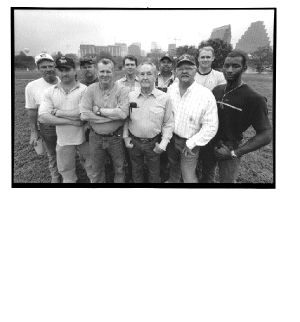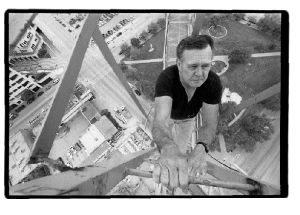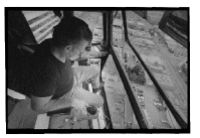Riding the Boom
Wading through downtown Austin with the last of the unendangered cranes.
It’s 3 o’clock in the afternoon and Wayne Parsons sits in an 8 by 8 by 7 foot box of steel and glass suspended 180 feet above downtown Austin. “Trolley up,” comes an order over the walkie-talkie that hangs by Parsons’ ear. He moves a lever in response, focused intently on a steel column dangling on the end of his cable far below. It is March and the afternoon is cool, in the 50s, but inside the cab it is close to 80 degrees.

“If it’s 100 [outside], it’s 120 in here,” says Parsons of the late model Leibner tower crane he operates on the corner of Guadalupe and Seventh Streets. Of the cranes now operating in Austin, this is one of the oldest. “It’s not built for comfort,” he says.
Since Austin’s boom in the mid-1980s, new construction has kept more than a dozen local operators busy at any given time. Despite the recent economic slowdown, cranes are still everywhere. From conventional ground cranes to high tower cranes, these strange and beautiful machines have become a part of the city’s landscape. At least for now.

Since modern construction is so dependent on these cranes, operators are routinely required to work 12-hour days, often getting only a few minutes to stand, eat, and use the bathroom. In tower cranes, where space is limited and the ground dozens of flights down, a bathroom often consists of an oil funnel attached to a garden hose.
“It gets lonely up there,” says Bruce Conner, who now prefers to work conventional cranes whenever possible. An expert operator with nearly 30 years of experience, Connor worked oil rigs from Australia to Cameroon before settling outside of Austin. “When you have a lift, all you think about is that lift, and getting it down safely without hurting someone,” he says. “I have a simple rule. The longer you keep it in the air, the more likely it is to fall. [So you] get it up, know where it’s going, and get it there in a safe, expeditious manner.”
A cell phone rings in the tower crane cab near the corner of MLK and Red River. Twenty-six-year-old Trey Sanford answers. “It’s my buddy Anthony,” he says in a moment. “He’s working over there.” He points downtown to the high twin tower cranes that loom over Seventh Street. Because there is no official crane operator certification, nor any local courses that offer technical training, the success of aspiring operators depends a great deal on having family connections or friends in the trade. A third-generation Austin operator, Sanford recalls climbing in a cherry picker when he was a toddler and sitting in a Wolfe tower crane with his granddad “Sandy” when he was eight.
“You are your own boss up here,” says Sanford. “And you’ve got a good view.”

Jody Horton is a photographer living in Austin.



